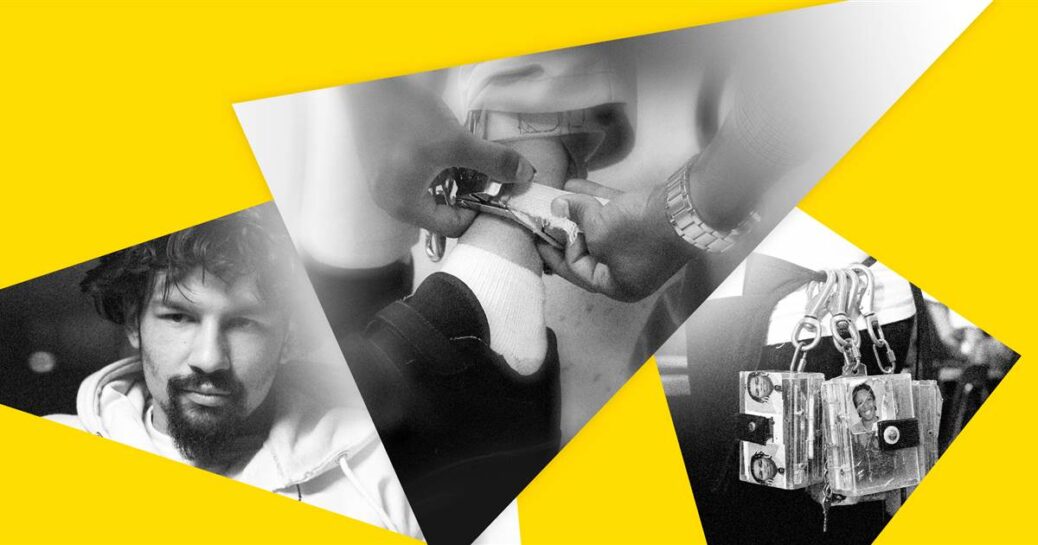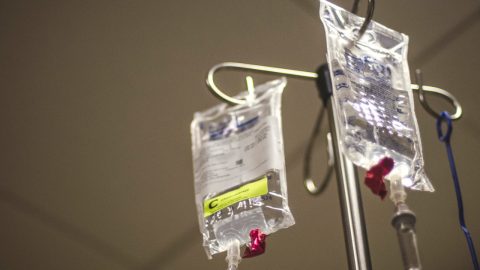
Rico Torres was just eight the first time school staffers strapped electrodes to his legs and shocked him. They draped a 12-volt battery over his shoulders in a backpack, while a nearby teacher held a clear plastic box with a photo of his face attached. When Torres misbehaved, the teacher would reach inside the box and push a button that sent a two-second jolt of electricity coursing through his body.
Under his court-approved treatment plan, Torres could be shocked for threatening to hit another student or for running away, swearing or screaming, refusing to follow directions or “inappropriate urination,” according to court records obtained by NBC News. One employee, he said, used to shock him in his sleep.
“Because I didn’t wake up, she shocked me,” recalled Torres, now 24. “Then I ended up peeing the bed, so she shocked me again.”
The electrodes stayed on his skin 24 hours a day for most of a decade, until he was 18. The device, called a graduated electronic decelerator (GED), was part of his treatment at Judge Rotenberg Educational Center in Canton, Mass., which has for half a century been one of the most controversial institutions for people with disabilities in the country. It’s thought to be the only place in the world that uses electric shocks to modify behavior — a treatment the United Nations has called torture.
In early March last year, just one week before the declaration of the Covid-19 pandemic, the Food and Drug Administration took the rare step of banning the device, finding that the significant risk of harm outweighed any medical benefit it could bring. It is only the third such ban in the agency’s history.
It seemed like the culmination of a decades-long battle between disability rights activists, former residents and the state of Massachusetts on one side — pushing to stop the use of the device or shut the school down altogether — and the center and its supporters, many of them parents who say the school, and the shock device, saved their children’s lives.
The ban should have meant victory for those fighting the school, but more than a year later, it hasn’t actually changed anything. Due to court battles and the pandemic, none of the 55 residents currently approved for treatment with the device will be required to transition off it until further legal decisions. If past litigation over the school’s use of the GED is any indication, that could be years.
Supporters say that the methods used by the center, which serves a mix of children and adults, are the best and sometimes last hope to address some of the most difficult developmental and emotional disability cases in the country. Many students at the center have severe autism spectrum disorders and are non-verbal and dangerously self-harming — some have been kicked out of or rejected by half a dozen other schools and treatment programs.
The GED is “only used as a treatment of last resort, and its recipients are at risk of grievous bodily harm, or even death, without it,” the Judge Rotenberg Center and the JRC Parents Association said in a joint statement. The groups called the FDA ban “arbitrary and capricious” and the GED a court-approved and monitored “life-saving” treatment.
Today, those approved for the device are all over the age of 18 with severe developmental disabilities. Some were first put on it years or even decades ago, when they were children. The FDA ban required new treatment plans for anyone on the device and for them to be moved off it within 180 days. Those transitions are now stalled while the pandemic state of emergency remains in effect. JRC is also challenging the ban in federal court.
When the ban was announced, disability rights advocates rejoiced. Nancy Weiss, who has been advocating against the use of painful procedures at JRC since 1993, recalls weeping on the phone with a former school resident. “We really thought that was it, but it’s not,” she said a year later.
Weiss, the director of the National Leadership Consortium on Developmental Disabilities at the University of Delaware, keeps a running timeline of all the efforts to change the school’s practices or close it all together, and the extensive legal battles around it.
“I think it’s going to drag on,” she said. “I’m 67, I’m retiring this year. I think if I see the place close before I die, it will be a miracle.”
‘Drugged up to the gills’
The Judge Rotenberg Center has been controversial since its start in the 1970s. It was established, under a different name in neighboring Rhode Island, to take the most difficult cases and use aversive, or negative, consequences to modify behavior — from slaps with paddles to pinches, white noise helmets, and noxious smells like ammonia. The controversy grew after the center created the GED in the early 1990s, generating national media attention and a slew of lawsuits.
The school said the GED worked in cases where other treatments did not, but it also found that over time the efficacy of the device declined for some students. So the institution created a second version of the device with a stronger electric current, which JRC’s founding director Matthew Israel told NBC News is “much more powerful” and “much more effective.”
JRC has long defended its practices as the most humane approach for the most challenging-to-treat cases. The shock device “has no detrimental effects whatsoever,” Israel told ABC News in 2007. In a conversation at the time with correspondent Cynthia McFadden, now with NBC News, he said the GED had to hurt to work and pushed back against allegations that the device was torture.
“The real torture,” Israel said, “is what these children are subjected to if they don’t have this program. They’re drugged up to the gills with drugs that cause them to be so sedated that they essentially sleep all day.”
The school has weathered controversy thanks to a team of lawyers and a core group of devoted family members like Louisa Goldberg, a longtime parent advocate. Like many of the school’s staunchest defenders, her son Andrew arrived as a teenager, and has remained there for two decades.
In 2019, JRC assembled a group of 30 family members of residents, who spoke to NBC News about the struggles they faced seeking care for their loved ones, many of whom have histories of severe self-harm. They were hospitalized, retrained, drugged into stupors and secluded in padded rooms, the families said. They argue — to courts, to the FDA, and to NBC News — that JRC and its unorthodox practices saved their children’s lives.
“This treatment is just wonderful,” said Goldberg. Before arriving at JRC, Andrew was extremely aggressive, she said. He was heavily medicated and restrained until he “ultimately became a zombie,” she said, but after going on the GED, his aggression stopped and his personality came out.
Goldberg’s story was echoed by the gathered families. When nothing else worked, they said, and nowhere else would take their loved ones and provide full-time care, JRC did. So the parents are fighting to keep the school open, and fighting hard.
‘That hurts!’
Their opposition includes disability rights activists and former residents like Torres, who say the GED is extremely painful and used to control minor misbehavior like swearing or failing to follow directions (JRC disputes both claims).
Torres, who was sent to the school for severe behavior disorders, was born to deaf parents who lost custody of him for substance abuse-related neglect when he was three. He spent his early childhood bouncing between schools, treatment programs and several psychiatric hospitalizations due to violent behavior.
By the time he was seven, Torres had been diagnosed with a range of disorders from ADHD to attachment disorder and his behavior had become increasingly violent. After a psychiatric hospitalization, he was transferred to JRC. A year after he arrived at the school, they fitted him with the backpack he would wear for most of the next decade.
“I was really aggressive as a child,” Torres said. “I don’t know where my violence came from, but I know that my mom and my dad weren’t the best of parents.”
Torres said that the shocks did not give him what he needed most — help in communicating with others, given his early childhood in a non-speaking home. He still struggles with it.
“What they’re doing is just taking people that have issues and just building more,” he said.
Activists point to a history of scandals as examples of how the GED can be abused and why the school should be shuttered. Three students died at the school between 1985 and 1990, including one who died while restrained. After the introduction of the GED in the early 90s, the most controversial cases centered around the device.
In 2002, resident Andre McCollins was tied to a restraint board for seven hours and shocked 31 times after he didn’t take off his jacket when told to. The episode only became public a decade later, when a video of McCollins screaming “Stop! Stop!” and “That hurts!” while being repeatedly shocked surfaced during a lawsuit brought by his mother. McCollins spent more than a month hospitalized after the incident, never returning to JRC.
In 2007, another student was shocked 77 times in just one night, after a prank caller instructed staff to do so. Several years later, director Matthew Israel was accused of destroying a surveillance tape of that night and indicted on obstruction of justice charges. Israel entered a deferred prosecution agreement, which let him plead not guilty, but required five years probation and that he resign as director of the school, which he’d run for 40 years. The charges were dismissed after the probation period.
Israel is now retired and living in California. He told NBC News that while he knows the treatment is not popular, the GED was necessary for cases where nothing else worked, and he believes he made a “contribution to mankind” by pioneering the use of the GED.
Back in Massachusetts, Glenda Crookes, who took over as executive director when Israel stepped down in 2011, said the incidents that sparked public outcry are all in the past. “We made countless changes to our policies and procedures, including limitations to the GED device and a different set of training for the staff that are certified to utilize the GED device.”
‘Very few places’
Many of those who have been put on the GED are non-verbal, so cannot speak for themselves, but several former residents who wore the device for years testified to the FDA when the agency was considering the ban, sharing their negative experiences.
“Most of the times [after getting shocked] I would get a very bad muscle cramp that would last me for one to two days. I would get burn marks on my skin,” said one.
“My experiences from the GED have affected me to this very day,” said another. “I now suffer from a fear of authority, a fear of being controlled, and I panic when presented with either.”
NBC News spoke to three behavioral health experts, who described the use of painful, negative feedback as an obsolete treatment.
“Many years ago, people thought maybe you would learn faster if you not only got things that you like when you did something people wanted you to do, but if you had some negative event right after you do something you’re not supposed to,” said Catherine Lord, distinguished professor of psychiatry at the UCLA School of Medicine, whose research focuses on autism and related disorders. “There was some data that people did learn faster, but the point was that once the negative goes away, the old habits come back.”
For lasting change, experts told NBC News, research supports developing positive behaviors through teaching and rewarding the alternative, less-harmful behaviors, rather than just de-incentivizing undesirable ones. Part of the challenge, though, of applying that research to severe self-harm cases is that they often require specialized, round-the-clock care that can be near impossible to get.
“As a country, we don’t have adequate services for kids who really need very significant, specialized and often 24-hour support,” Lord said. “There are very few places in the United States that address this well, and those spots are hard to come by and they’re very expensive.”
JRC has long filled that gap, advertising its “near-zero rejection/expulsion policy” to desperate parents and school systems with nowhere else to send children. Today, many of the school’s students, though not necessarily those wearing GEDs, are teenagers of color with emotional and behavioral issues sent by schools, family courts and the juvenile justice system, many from New York City’s low-income areas.
Torres was one of those students. He said he was also one of the few students without severe developmental disabilities using the GED. He was put on the device roughly a year into his time at the school because “less intrusive behavior modification techniques” had not been successful, according to his treatment plan, which had to be approved by a local judge.
In his final years there, still wearing the GED, the FDA began looking into the device. The agency assembled a panel of experts to study it, held hearings, and received thousands of pages of testimony and documentation from the school. After two years, the FDA announced it would ban the GED, but took another four years to finalize the rule.
It finally banned the devices on March 6, 2020, stating “they present an unreasonable and substantial risk of illness or injury.” The ban applies to a category of “electrical stimulation devices used for self-injurious or aggressive behavior,” but, the agency noted, only one facility in the country uses such devices — the Judge Rotenberg Center.
JRC decried the ban, saying in a statement that it would prove in court that during its rulemaking process, the FDA “abandoned science” and “ignored countless hours of testimony and volumes of information, and hid expert testimony supporting the use of the GED.”
It has since petitioned a federal court to review the ban. JRC has successfully used courts to quash opposition through decades of government challenges, including actions by the states of Massachusetts and New York, and the federal Centers for Medicare and Medicaid. A ruling in favor of the school after one state attempt to stop it from using aversives in the 1980s, before the use of the GED, led the school to rename itself after the judge that ruled in its favor.
With around 275 residents, at an average cost of $275,000 per student per year — largely covered by state governments and school systems, JRC takes in more than $78.6 million in gross receipts yearly, according to recent tax documents. The school has a lawyer who has represented it for more than 30 years. It paid his firm $1.7 million in 2018.
During his time at JRC, Torres said he was one of the youngest people on the device, and one of the few able to speak. He describes it as an isolating, humiliating experience. Torres has been back in New York City for three years now, but said he is still trying to figure out how to function in regular society.
He spent nearly half his life attached to the GED, and much of his living memory. When he finally had his electrodes removed, he said he began having cravings and trouble sleeping.
“My pain tolerance has gone to the point that I can’t really feel anything. I get tattoos as a reminder of it,” Torres said. “Sometimes all I crave is pain.”









Recent Comments